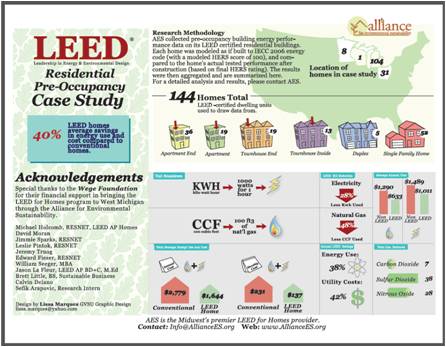In a newly-released report, the Green Home Institute () analyzed data from LEED-certified homes in the Midwest found that the homes averaged 40% less energy use and utility costs annually when compared to conventional homes.

LEED for Homes Case Study Report
From January through June 2010, the Green Home Institute () collected building energy performance data for research on the Energy Efficiency of homes certified to the LEED (Leadership in Energy and Environmental Design) rating system, a green building certification that focuses on performance-based verification.
Report Methodology
The research compiled information from pre-occupancy energy modeling of 144 LEED-certified projects that were located in the Midwest from climate zones ranging as far south as Cincinnati to as far north as Minneapolis. The Data shows numerous advantages in energy reduction and costs in than baseline average homes measured by the same energy modeling system.
• All data is based on comparing pre-occupancy computer modeling data of LEED homes against non-LEED homes with a HERS score of 100 and does not in any way represent post-occupancy performance or actual savings realized through any home utility bills
• Kwh and CCF savings results may be skewed by unique systems installed on various homes such as; Renewable Energy, Geothermal heating/cooling, Propane, Electric Heating (Water Heating) and average regional energy prices.
This report does not cover the full benefits of a LEED-certified house because it only focuses on energy in regards to electricity in Kilowatt-hours and heating in CCF’s. Benefits not addressed include of the home’s water reduction, biodiversity, reduced risk of sick home syndrome, improved quality of life and comfort, reduced waste sent to the landfill, reduced urban sprawl and many other benefits associated with a LEED certified home. Because LEED homes are third-party verified,
Energy modeling was performed individually be the energy rater for each home, and in its nature is only a predictor of the building design case compared to the typical behavioral use patterns in the typical home in the typical climate zone, so true performance rates will vary.
Report Findings
After aggregating the data across all 144 LEED-certified homes, trends started to emerge. Homes that received the LEED for Homes third-party green building certification save 38% in energy use and save 42% in costs, with the following specific breakdown.
- 28% less KWH’s with 32% electricity savings
- 48% less CCF’s with 51% heating savings
- 7 lbs C02 Emissions Reduced
- 38 lbs Sulfur Dioxide Emissions Reduced
- 28 lbs of Nitrous Oxide Emissions Reduced
We then further isolated groups to compare performance across different LEED certification levels:
- LEED Platinum homes saw, on average, a 41% savings in total energy consumed and a 46% savings in total costs incurred.
- LEED Gold certified homes save 46% in energy use and save 42% in costs.
- LEED Silver certified save 29% in energy use and save 24% in costs.
- Standard LEED Certified homes save 30% in energy use and save 30% in costs.
Utility Savings Across LEED Homes
We see above that a LEED-certified home will be in a better position when it comes to the consumption of energy, whether it be electricity or gas. By extension, these certified green homes also be in a better financial position, as the home will render less operational costs to its owner. Annually, LEED-certified homes bring the following annual utility savings:
- LEED Platinum homes saw, on average, $1,869 savings in annual utilities.
- LEED Gold homes saved $1,026 in annual utilities.
- LEED Silver saved $256 in annual utilities.
- Standard LEED Certified homes save 30% in energy use and save 30% in costs.
An interesting note here is that the selection of LEED Silver homes were skewed as 23% of the homes in the study were affordable housing homes (e.g. Habitat for Humanity), all certified at the LEED Silver level. These homes were generally smaller and more efficient, offering less savings in annual utilities.
Value of LEED Homes
Now if we think about the total cost of ownership for a property, we can take traditional inputs such as principal mortgage payment, interest on the loan, property taxes, and home insurance (PITI) and add in utilities to the mix. This is the premise of the SAVE act, a pending congressional bill that would include utilities in the underwriting process. We can take the annual utility savings, and assume a 3% annual inflation rate (quite conservative – and less than the mortgage rate a property is likely to receive). Using a financial calculator to see the value over the life of the mortgage with this, we can see the contributory value of utilities, broken down by LEED certification level. The calculations are based on a real estate appraisal journal article:
- LEED Platinum homes receive $88,919 in utility savings over 30 years.
- LEED Gold homes receive $48,813 in utility savings over 30 years.
- LEED Silver receive $12,179 in utility savings over 30 years.
- Standard LEED Certified homes receive $54,188 in utility savings over 30 years.
Conclusion
The value of the performance-based LEED for Homes standard is clear. LEED-certified homes reduce the total cost of ownership at every level of LEED certification, saving tens of thousands of dollars through utility savings, during a typical 30-year mortgage period. Given the average $2,500 certification cost for a single-family LEED home through , owners will typically have a payback period under 2.5 years. Contact to help you through LEED Certification on your next residential green building project.
